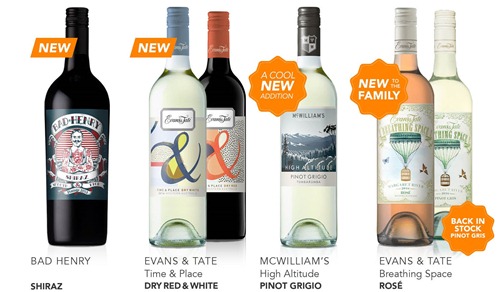By Deborah Jackson, editor National Liquor News
Following on from a year of company restructure and portfolio rationalisation, McWilliam’s Family Winemakers has turned its attention to creating innovative new products that will unlock profits for the independent trade.
From October 2014 to December 2015, McWilliam’s reduced the number of wines in its portfolio from approximately 440 to 285, while the sale of Brand’s Laira added a further reduction of around 20 SKUs. According to national business manager – independents Jamie Single, this period of rationalisation allowed the company to gain a clear picture across the business of what its core portfolio would look like for the next three years.
“This (rationalisation process) has enabled us to identify any gaps and be more disciplined in our approach to NPD to ensure any new wines we are creating actively drive category growth by resonating strongly with Australian wine drinkers,” said Single.
Working hard to increase your profits
So the question is, which categories are seeing the most growth? According to the ALSA-IRI State of the Industry Report released in March, Pinot Grigio is the fastest growing and most significant dollar contributor to Bottled White growth, having accounted for 46 per cent of the segment’s dollar growth in 2015.
In line with this, McWilliam’s has introduced a Pinot Grigio into its High Altitude series. McWilliam’s has been championing the emerging Tumbarumba wine region, which according to IRI Data MAT 20/3/16, is the fastest growing region in NSW.
That same IRI data shows wines priced at more than $12 are driving the wine category growth as consumers are trading up to more premium offerings. So, all of the new release wines from McWilliam’s are positioned within this price segment.
In April, during a panel discussion held at the IRI head office in Sydney, David Reberger from Kemeny’s and LSA NSW, said that Rosé appears to be increasingly popular in the wine sector. "If there's one big trend, it is Rosé. Historically, we would look at our reds and our whites, but you can take Rosé out now as a separate category and I think rosé is definitely here to stay,” he said. And so Evans & Tate Breathing Space has introduced a Rosé into its line-up, in order to capatalise on this growing trend.
Pinot Gris is the other positively trending varietal, according to the ALSA-IRI State of the Industry Report, recording solid growth of eight per cent in 2015 on the back of 13.8 per cent gains in 2014, and Evans & Tate Breathing space is pleased to announce its Pinot Gris is now back in stock.
Wine quality that over delivers on price
According to Evans & Tate brand manager George Stupart, the past six months have been difficult, having to have the conversation with independent retailers around delisting products. But now, there are new products to take their place, products which have been largely customer led and products that are going to deliver great margins for retailers.
“Whilst the Australian wine market is seen as mature, engaged higher spending consumers will always have a thirst for new and innovative offerings, by catering to their needs retailers can drive higher margins and loyalty,” said Stupart.
As for brand new products, McWilliam’s has created Bad Henry Shiraz (RRP $18), sourced from Australia’s leading Shiraz regions and the Evans & Tate Time & Place Dry Red and Dry White (RRP $13).
According to Stupart, these wines have been aligned to retailer’s needs around profitability and customer loyalty. “There’s four main insights that we’re aligning to. Two are based on the retailer’s needs, which is about profitability – so the margins in these products are great; and over-deliver on category norms. The other is around loyalty – by introducing new independent exclusive products from well-loved brands, we are helping retailers create a point of difference that shoppers will keep coming back for,” he said.
“I would challenge retailers to review their current offering with the same level of rigour as we have reviewed our own portfolio and if any wines on their shelves aren’t over delivering on their or their customer’s needs make space for one that does.”


It is good to see the big companies starting to understand that without the indies they would only have the big boys to deal with!
However what happens when the indies grow these brands, will they have to let Coles & Woolies have them, as can they afford to say no when they ask!
There are enough good small wineries out there that will never sell to the majors, so why not continue to work with the small wine company’s as without them there will never be a choice.
Small company’s should look after one another as this is the only way we will all survive!